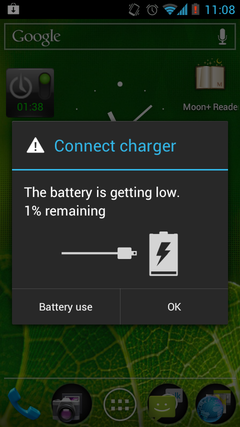A first-of-its-kind study of Android-supported smartphones in everyday use has revealed that apps drain 29% of battery power while the screen is off.

Research was conducted by researchers from Purdue University, Intel Corporation, and startup company Mobile Enerlytics. In the group’s paper, they detail the results of having studied the use of 2,000 Samsung Galaxy S3 and S4 phones, served by 191 mobile operators in 61 countries.
“This was the first large-scale study of smartphone energy drain 'in the wild,' or in everyday use by consumers,” said Y. Charlie Hu, a Purdue professor of electrical and computer engineering.
Diving into the numbers a bit, of the 46% battery drain a phone experiences when its screen is off, 29% is due to apps that wake the phone up and run in the background. To circumvent this unnecessary drainage, the researchers created a software tool that eliminates 16% of the drain.
The solution is called “HUSH” and it is available for free here.
“During screen-off, the phone hardware should enter the sleep state, draining close to zero power,” Hu explains. “Apps wake the phone up periodically during screen-off to do useful things, but then afterward, they should let the phone go back to sleep. They are not letting the phone go back to sleep because of software bugs and, specifically, due to the incorrect use of Android power control application programming interfaces called wakelocks.”
“We presented the first study a few years back showing wakelock bugs could cause significant energy drain,” Hu added. “But this is the first study showing that wakelock bugs appear prevalent on real users' phones.”
The key to making HUSH work so well is its ability to identify background activities of individual apps that aren’t necessarily important to individual smartphone users. Case in point: a Facebook user who checks his / her feed and posts notifications often may want the app to update regularly during screen-off periods so that when it is opened, the most pertinent information appears at the top. Continuous updates like this are perhaps a bit less necessary to users who don’t open the app as often. HUSH is able to identify the app background activities most useful to the user and suppress those not as important during screen-off periods which, in turn, reduce overall battery drain.
Looking ahead, Hu and team will work to expound upon their software’s capabilities to target drainage caused by the phone’s maintenance programs. Examples of this include the device’s WiFi beacon, wherein its WiFi system sends periodic signals to the access point (occurs once every 200 milliseconds), and “cellular paging”, in which the phone contacts the base station once every 1 to 2 seconds to check for incoming calls, messages, and data. The research team hopes to create a program that will reduce energy loss from such programs, along with that which is caused by faulty apps.
“The big picture is that we want to double the battery life for smartphones,” Hu said. “This is going to be a non-trivial journey because much of the battery drain is caused by various apps when the screen is on and also legitimate maintenance functions.”
Research is ongoing, with implications to the 5G wireless network design.
Read the full study “Smartphone Background Activities in the Wild: Origin, Energy Drain, and Optimization”.
Advertisement
Learn more about Electronic Products Magazine





